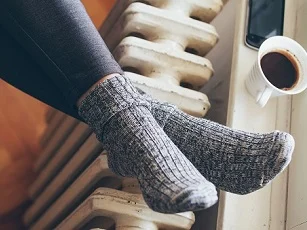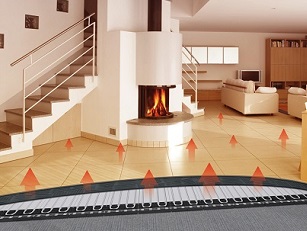 Free delivery on orders over £75 ex VAT
Free delivery on orders over £75 ex VAT Free click & collect from branches nationwide
Free click & collect from branches nationwideWith winter fast approaching, you are no doubt getting yourself ready for chillier evenings and crisper mornings. Cue: big warm blankets, thick coats, and switching the heating on. If you have made the decision to install new radiators before the temperatures really begin to drop, this will not only help to improve the efficiency of your home’s heating, but it will also help to transform the room that they are in.
To help you get prepared for the cooler climate and ensure that you can be as cosy as possible this season, we’re here to provide you with some tips on which radiators would work best for your home. We’ll answer the questions, ‘where is the best place to put a radiator?’ and ‘which are the best radiators for a living room?’ as well as provide you with tips on how to keep them well maintained.

Read below to find out what you need to consider when buying your new radiators.
Electric vs plumbed radiators
In your home, you will either have a plumbed hot water central heating system, or electric radiators. Before making the decision to either update your current radiators or choose completely new ones, it’s essential that you calculate the BTU (British Thermal Unit) energy requirement of each space in your house. A BTU is a measure of heat output from a radiator. Once you are aware of how much heat each room will need, you can then choose the size, type and style of radiator that best suits your tastes.
Plumbed hot water systems use a boiler which heats the water and circulates it around your home through pipes, whereas electric radiators only require a mains electricity supply in your home, and are controlled in each individual room.
The benefits of both
Central heating radiators, or electric radiators? No matter what you end up going for, there are a number of benefits to both.
Central heating systems
Central heating systems are fully controllable, meaning that if you want to set each room to a different temperature, or set a timer for a certain time to heat up a room, you can, as you will have full use of a timer, room thermostat and thermostatic radiator valves.
Electric radiators
Electric radiators will convert all of the energy they use into heat, meaning that they can heat up a lot faster than gas-powered ones. There are also no expensive installation costs involved with an electric choice, as there is no need to bring up floorboards and lay pipework.
Which radiator should go in which room?
So, where is the best place to put a radiator? First things first: where would you like to hang your radiator? Before deciding what radiator you’d like to go in what room, it’s worthwhile considering the type of wall that it’s going to be hung on, as this will provide you with some clues as to what size and style you should choose.
Large radiators can easily be hung on solid walls constructed of brickwork, blockwork or masonry, but if your wall is constructed from plasterboard, you’re going to have to find out where the studs run. As these are the strongest part of your wall, it’ll be a lot safer to hang your new radiator from there.
In order to find out what kind of wall you have, try knocking on it and then listen to what sound it makes. If your wall is solid, you won’t hear any reverberations, whereas if it’s made out of plasterboard, you’ll hear a much louder sound.
The kitchen
The kitchen is the heart of the home, and while it is generally the warmest room in the house, you’re still going to want to keep it heated in the winter. In order to ensure your kitchen is well-heated yet stylish, you could choose to install a vertical designer radiator or chic heated towel rail. Both will work wonders in keeping the chill off when the oven or hob isn’t in use, while looking great at the same time.
The lounge
What are the best radiators for a living room? If, like many others, you like to curl up and get cosy in the living room every evening over winter, you’re going to be spending a lot of time in this room – and you’ll want it to be warm. Selecting one of the best vertical radiators and popping it in this part of the house would be the perfect choice: they look great, make a statement and help to maximise space. If you’d prefer something a little more traditional, you could consider a horizontal radiator and pop it underneath a window, as this is usually dead space.
The bathroom
As with every other room in your house, the size of your bathroom will have an impact on which radiator you buy for this space. Heated towel rails are some of the best bathroom radiators that you could invest in, as they are perfect for heating a room while drying towels at the same time. However, you could also pop a column radiator in there if you have the space.
Tips for maintaining your radiators
Once you have invested in your new radiators, it’s essential that you keep them maintained.
Cleaning your radiator
If you’re looking for the best way to clean a radiator, start by turning off your heating. From there, vacuum it thoroughly to remove any dust, before using a long brush to get down the back of it. Then, use a sponge and warm soapy water to wipe down the outside, pipework and valves.
Bleeding your radiator
If your radiator feels cold at the top but hot at the bottom, there may be trapped air in there. If so, the best way to bleed a radiator is to turn off the central heating system fully and wait for it to cool. From there, open the bleed valve to enable the trapped air to escape, and you should be able to hear a hissing sound. Be aware that a little bit of water might escape, so it’s always a good idea to pop a cloth underneath.
Installing one radiator – or more – can be a fairly tricky job. If you’re not a DIY enthusiast, or don’t feel confident doing the installation yourself, it’s best to get a professional tradesperson in to do it. It will be a routine job for them, meaning that they will be in and out of your home quickly, and you’ll be able to start enjoying your new radiators in no time!
No matter the style you’re looking for, we’ll have the heating solution. If you have any questions about radiators, the different types or which ones you should buy for your home, please feel free to come down and see us. We have more than 370 locations across the UK, so use our branch finder to seek out one of our experts and get the answers that you need.
Other articles

Smart Home Heating Controls: A Guide for Homeowners
04 Mar 2022 ・ 4 mins

How to become a renewable energy engineer
03 Mar 2022 ・ 7 mins

Electric or water underfloor heating? An installer's guide
03 Mar 2022 ・ 5 mins

